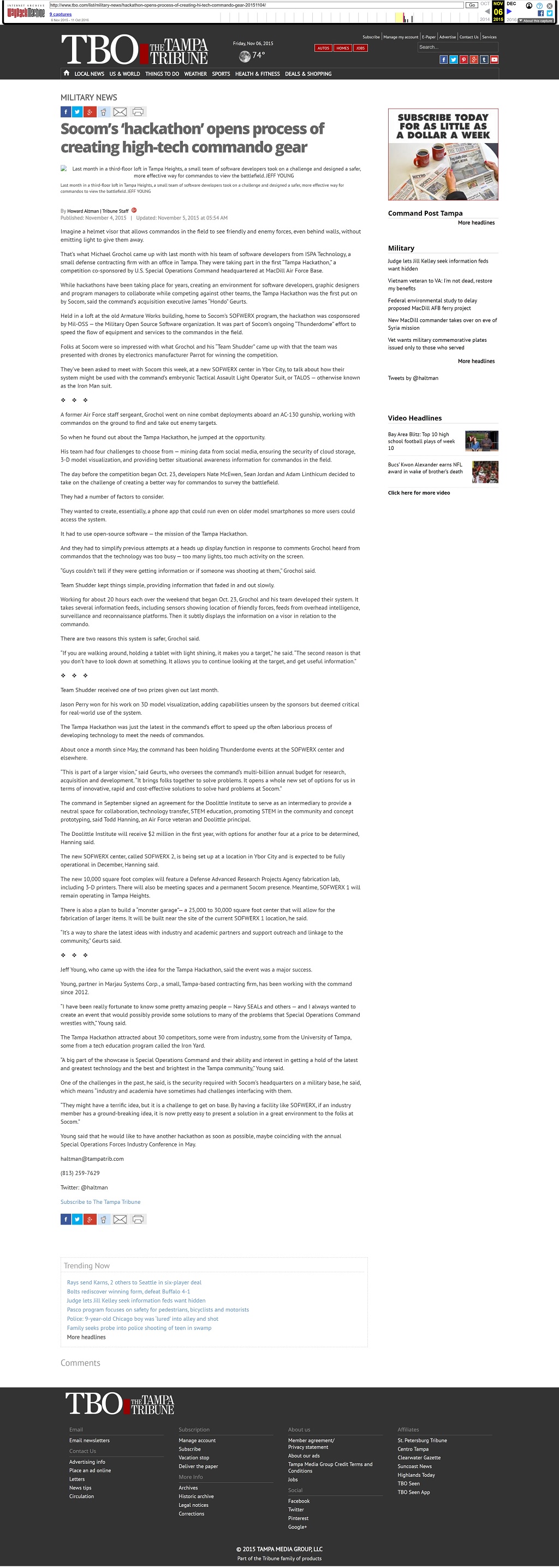The Tampa Tribune / TBO.com
Military News
Imagine a helmet visor that allows commandos in the field to see friendly and enemy forces, even behind walls, without emitting light to give them away.
That’s what Michael Grochol came up with last month with his team of software developers from ISPA Technology, a small defense contracting firm with an office in Tampa. They were taking part in the first “Tampa Hackathon,” a competition co-sponsored by U.S. Special Operations Command headquartered at MacDill Air Force Base.
While hackathons have been taking place for years, creating an environment for software developers, graphic designers and program managers to collaborate while competing against other teams, the Tampa Hackathon was the first put on by Socom, said the command’s acquisition executive James “Hondo” Geurts.
Held in a loft at the old Armature Works building, home to Socom’s SOFWERX program, the hackathon was cosponsored by Mil-OSS — the Military Open Source Software organization. It was part of Socom’s ongoing “Thunderdome” effort to speed the flow of equipment and services to the commandos in the field.
Folks at Socom were so impressed with what Grochol and his “Team Shudder” came up with that the team was presented with drones by electronics manufacturer Parrot for winning the competition.
They’ve been asked to meet with Socom this week, at a new SOFWERX center in Ybor City, to talk about how their system might be used with the command’s embryonic Tactical Assault Light Operator Suit, or TALOS — otherwise known as the Iron Man suit.
A former Air Force staff sergeant, Grochol went on nine combat deployments aboard an AC-130 gunship, working with commandos on the ground to find and take out enemy targets.
So when he found out about the Tampa Hackathon, he jumped at the opportunity.
His team had four challenges to choose from — mining data from social media, ensuring the security of cloud storage, 3-D model visualization, and providing better situational awareness information for commandos in the field.
The day before the competition began Oct. 23, developers Nate McEwen, Sean Jordan and Adam Linthicum decided to take on the challenge of creating a better way for commandos to survey the battlefield.
They had a number of factors to consider.
They wanted to create, essentially, a phone app that could run even on older model smartphones so more users could access the system.
It had to use open-source software — the mission of the Tampa Hackathon.
And they had to simplify previous attempts at a heads up display function in response to comments Grochol heard from commandos that the technology was too busy — too many lights, too much activity on the screen.
“Guys couldn’t tell if they were getting information or if someone was shooting at them,” Grochol said.
Team Shudder kept things simple, providing information that faded in and out slowly.
Working for about 20 hours each over the weekend that began Oct. 23, Grochol and his team developed their system. It takes several information feeds, including sensors showing location of friendly forces, feeds from overhead intelligence, surveillance and reconnaissance platforms. Then it subtly displays the information on a visor in relation to the commando.
There are two reasons this system is safer, Grochol said.
“If you are walking around, holding a tablet with light shining, it makes you a target,” he said. “The second reason is that you don’t have to look down at something. It allows you to continue looking at the target, and get useful information.”
Team Shudder received one of two prizes given out last month.
Jason Perry won for his work on 3D model visualization, adding capabilities unseen by the sponsors but deemed critical for real-world use of the system.
The Tampa Hackathon was just the latest in the command’s effort to speed up the often laborious process of developing technology to meet the needs of commandos.
About once a month since May, the command has been holding Thunderdome events at the SOFWERX center and elsewhere.
“This is part of a larger vision,” said Geurts, who oversees the command’s multi-billion annual budget for research, acquisition and development. “It brings folks together to solve problems. It opens a whole new set of options for us in terms of innovative, rapid and cost-effective solutions to solve hard problems at Socom.”
The command in September signed an agreement for the Doolittle Institute to serve as an intermediary to provide a neutral space for collaboration, technology transfer, STEM education, promoting STEM in the community and concept prototyping, said Todd Hanning, an Air Force veteran and Doolittle principal.
The Doolittle Institute will receive $2 million in the first year, with options for another four at a price to be determined, Hanning said.
The new SOFWERX center, called SOFWERX 2, is being set up at a location in Ybor City and is expected to be fully operational in December, Hanning said.
The new 10,000 square foot complex will feature a Defense Advanced Research Projects Agency fabrication lab, including 3-D printers. There will also be meeting spaces and a permanent Socom presence. Meantime, SOFWERX 1 will remain operating in Tampa Heights.
There is also a plan to build a “monster garage”— a 25,000 to 30,000 square foot center that will allow for the fabrication of larger items. It will be built near the site of the current SOFWERX 1 location, he said.
“It’s a way to share the latest ideas with industry and academic partners and support outreach and linkage to the community,” Geurts said.
Jeff Young, who came up with the idea for the Tampa Hackathon, said the event was a major success.
Young, partner in Marjau Systems Corp., a small, Tampa-based contracting firm, has been working with the command since 2012.
“I have been really fortunate to know some pretty amazing people — Navy SEALs and others — and I always wanted to create an event that would possibly provide some solutions to many of the problems that Special Operations Command wrestles with,” Young said.
The Tampa Hackathon attracted about 30 competitors, some were from industry, some from the University of Tampa, some from a tech education program called the Iron Yard.
“A big part of the showcase is Special Operations Command and their ability and interest in getting a hold of the latest and greatest technology and the best and brightest in the Tampa community,” Young said.
One of the challenges in the past, he said, is the security required with Socom’s headquarters on a military base, he said, which means “industry and academia have sometimes had challenges interfacing with them.
“They might have a terrific idea, but it is a challenge to get on base. By having a facility like SOFWERX, if an industry member has a ground-breaking idea, it is now pretty easy to present a solution in a great environment to the folks at Socom.”
Young said that he would like to have another hackathon as soon as possible, maybe coinciding with the annual Special Operations Forces Industry Conference in May.

Original URL: http://www.tbo.com/list/military-news/hackathon-opens-process-of-creating-hi-tech-commando-gear-20151104/

